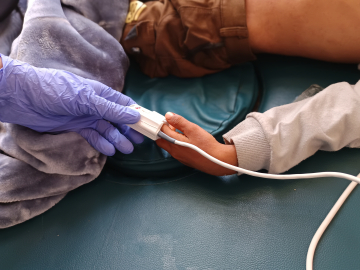Tom Frieden: Proposed CDC Cuts Would Mean More Cancer, Heart Disease and Stroke
NEW YORK – Tom Frieden is worried. Not about his new organization—Resolve to Save Lives—but his previous one: the CDC.
After 8 years leading the top public health agency in the US, Frieden remains a fierce advocate for the CDC’s mission and its staff.
President Trump’s proposed 20% cuts to the CDC has him concerned about the agency’s abilities to protect American health. “I am worried that if they don’t get the budget they need, they won’t be able to protect us effectively,” he says.
Frieden adds bluntly that the proposed budget cuts would mean “more cancer, more heart disease, more stroke.”
In this second part of a Q&A with Global Health NOW, Frieden shares his insights on the CDC’s budget needs, differences in federal funding for the NIH vs. the CDC, and the challenge of fighting noncommunicable diseases.
Given the Trump administration’s proposed 20% cut to the CDC’s budget, are you worried about the CDC’s future?
The CDC is a wonderful organization. It has a depth and a breadth that no other public health organization in the world has. It has the single most important resource that any organization can have, which is fantastic staff. By fantastic, I mean they’re technical experts. They’re ethically committed to their jobs. They’re smart. They’re strategic, and they’re dedicated.
I’m not worried about CDC. I am worried that if they don’t get the budget they need, they won’t be able to protect us effectively. If the administration’s proposal of a 20% cut in the CDC budget comes to pass, the country’s ability to mobilize in emergencies will be undermined. Our ability to stop outbreaks in this country… to what’s called the ELC [Epidemiology and Laboratory Capacity for Infectious Diseases] program, through a two-thirds proposed cut … will be compromised. This will pull the rug out of years of work helping other countries develop their systems so we don’t have to intervene. It will make it more likely that we have to fight diseases on our shores rather than fight them where they first emerge and where they can stop before they cause more problems.
And, if the budget is adopted, it will result in more cancer, more heart disease, more stroke. So, 103 years ago, [New York health commissioner] Hermann Biggs, in this city, wrote, “Public health is purchased. Within natural limitations, a community can determine its own death rate.”
And, you know the old saying: “Show me your budget, and I’ll show you your values.” Don’t tell me you care about preventing people from getting infected or dying from heart attacks and strokes, show me the CDC budget.
Does Congress have the CDC’s back in the way that it did for NIH in last year’s budget?
I’m really encouraged that Tom Cole [R-Oklahoma, chair of a House subcommittee on health and other issues] always puts CDC and NIH in the same breath. It would be good if whatever proportional increase NIH gets, CDC gets. If they can be yoked together in that way, the country will be safer and healthier. That hasn’t happened yet.
What way is that?
CDC funds health departments. NIH funds universities. 1 of those 2 entities is more effective at encouraging more funding. You can guess which, by and large. [Laughs].
It’s interesting, NIH, and I’m a huge believer in funding for things like the universal flu vaccine. It’s great, but it’s gonna take 10, 20 or 30 years. That doesn’t mean we shouldn’t do it. We should do it, but I don’t quite understand why that something that might work in 10 or 20 or 30 years gets more political traction and funding than something that we are virtually certain will work for a tiny fraction of the money in 2 or 3 years. I don’t understand that. Maybe I could have been more effective as CDC director in making that case.
But, as 1 example I’m using, CDC doesn’t have the money to effectively assess... all the different, current vaccine formulations on the market for flu. It would cost millions of dollars, but it would tell people, is a triple dose vaccine better? Is an adjuvanted vaccine better? I*s the cell-based vaccine better? We don’t know. Those studies aren’t cheap. They take 2 or 3 years, not 2 or 3 decades. They would give us a result that would give us a better flu vaccine in 3 or 4 years, and maybe our real hint on where the best universal vaccine would come from.
Did you understand why there wasn’t that kind of investment that you advocated for in Washington?
Well, we were able to get support, particularly during emergencies; H1N1, Ebola and Zika. Sometimes it’s hard for people to see the importance of what CDC does because when it succeeds, there isn’t an outbreak. Sometimes the people advocating for resources are more effective in other programs, or sometimes within CDC, people are advocating for very specific programs, not for the general CDC budget.
And, sometimes, there’s a perception that a lot of what CDC does is controversial, and that’s really not true. I once went through our budget and said if you even have a broad definition of controversial—and that might include anti-obesity work—it’s less than 5% of CDC’s budget. So, I think there may be a misperception of that.
I think this is not just a problem for CDC. It’s a problem for public health departments at city levels, at state levels, at globally, at the World Health Organization. We in public health need to get better at mobilizing resources. I wish I knew how.
That was my next question. What would that look like?
Well, when I started at CDC, Senator [Daniel] Inouye was chair of the Senate Appropriations Committee and I asked him that question, and he said, “Don’t tell us the good things that will happen if we give you the money, tell us the bad things that will happen to us if we don’t give you the money.” It was probably very good advice.
Last question: People intuitively understand epidemics, and they understand infectious disease so it’s easier in some ways to get government support for preparedness or emergency response. But what about the slow-moving noncommunicable disease epidemics? How do you confront those?
I think it’s very hard to get a sense of urgency at NCDs. In fact, this is a huge challenge; 10.5 million people die every year from untreated hypertension or inadequately treated hypertension. That comes to 7,000 a day, 300 an hour, [20] a minute. Multiply that by 2 for people with strokes or heart attacks who don’t die and who may be disabled or unable to care for their family, unable to speak, unable to walk...
This is a global emergency, but not seen as one because it’s slow moving. But, if we see the lives and the faces behind the numbers, we see how tragic it is.
The story that I remember about this is at the height of Ebola, we had a very wonderful driver in Sierra Leone who was waiting for our staff in the parking lot late at night. Staff came out, and he was having seizures and bleeding all over the place. Height of Ebola, [he] couldn’t be resuscitated safely [and] died. When the situation was investigated, he didn’t have Ebola. He had untreated hypertension and had died from a stroke. Could have been prevented with $2 a year of medicines.
That kind of tragedy is happening every minute all around the world.
Read part I of Frieden’s GHN interview here.
Join the tens of thousands of subscribers in more than 100 countries who rely on Global Health NOW summaries and exclusive articles for the latest public health news. Sign up for our free weekday enewsletter, and please share the link with friends and colleagues: http://www.globalhealthnow.org/subscribe.html
Tom Frieden introduces WHO Director-General Tedros and others to Resolve during an October meeting in Geneva. (Courtesy: Resolve to Save Lives)





